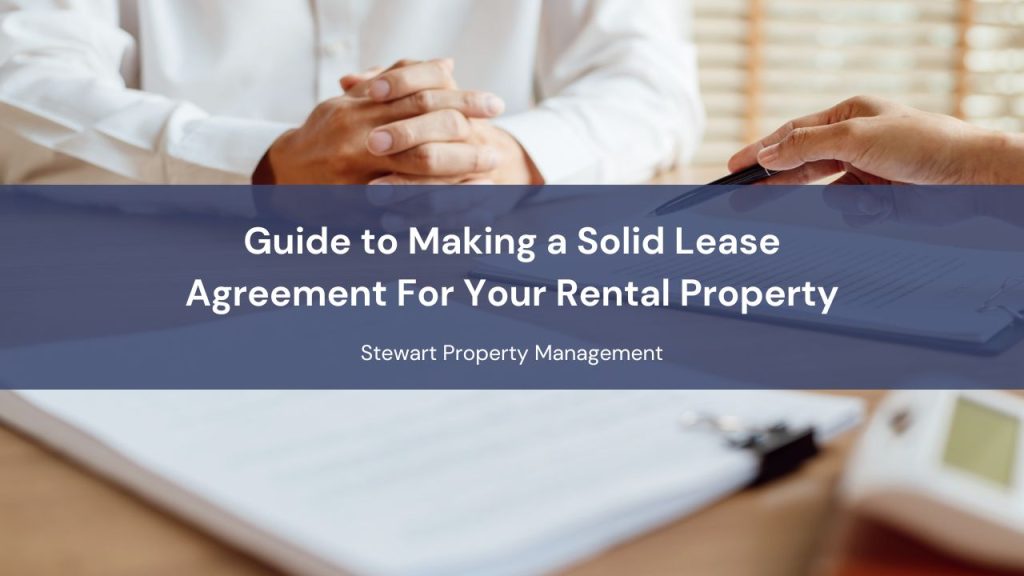Stewart Property Management – Greater Ottawa and Surrounding Areas
Key Takeaways
-
- A Lease Agreement is Essential for Legal Protection – A well-drafted lease agreement establishes clear expectations for both landlords and tenants, reducing the risk of disputes and providing legal protection in case of violations. Without it, resolving issues like rent payments, property damage, or lease termination becomes more challenging.
-
- Key Lease Clauses Ensure Clarity and Compliance – Important clauses such as pet policies, subletting rules, repair responsibilities, and early termination terms help landlords and tenants understand their rights and obligations. Including these in the lease ensures compliance with Ontario’s Residential Tenancies Act and helps prevent misunderstandings.
Leasing agreements are fundamental documents in the rental process. These written contracts establish the rights and responsibilities of both landlords and tenants, providing a legal framework for their relationship throughout the tenancy. Without a lease agreement, misunderstandings can arise, making it difficult to resolve disputes or enforce rules and responsibilities. A well-crafted lease not only helps ensure smooth interactions but also provides legal protection, safeguarding both parties from costly legal battles.
In this article, we at Stewart Property Management will explore the primary purpose of a lease, the essential elements it should contain, and the important clauses to include. We’ll also discuss the necessary disclosures landlords must provide and how a comprehensive lease can help avoid confusion and legal trouble.
Why Having a Lease Agreement is Crucial
A lease agreement serves as a written record of the terms and conditions both the landlord and tenant have agreed to. Without this document, disputes may arise that are difficult to resolve. Some common issues include misunderstandings regarding rent payment dates, deposits, pet policies, and maintenance responsibilities.
A well-written lease also protects landlords from legal challenges. For example, if a tenant violates the terms of the lease, such as failing to pay rent or causing property damage, the landlord can use the lease as evidence in court. This reduces the risk of costly lawsuits or lengthy legal battles, as the lease provides clear documentation of the terms both parties agreed to.

Key Components of a Lease Agreement
An Ontario Residential Tenancy Agreement is a legally binding contract between a landlord and a tenant that outlines the terms and conditions of renting a residential property in Ontario. Key elements of this agreement include:
-
- Standard Form of Lease – Ontario requires landlords to use the province’s official Standard Lease Agreement for most private residential tenancies.
-
- Parties Involved – Identifies the landlord(s) and tenant(s) by name and contact information.
-
- Rental Unit Details – Specifies the address and description of the rental unit, including any included amenities (e.g., parking, appliances).
-
- Lease Term – Defines whether the tenancy is fixed-term (e.g., one year) or month-to-month.
-
- Rent Payment – States the amount of rent, due date, acceptable payment methods, and any included utilities or services.
-
- Rent Increases – Must comply with Ontario rent control laws, typically allowing for annual increases within the prescribed guideline set by the province.
-
- Deposit and Fees – Limits landlords to collecting a rent deposit (first and/or last month’s rent) but prohibits security deposits or additional fees.
-
- Maintenance and Repairs – Outlines landlord responsibilities for property maintenance and repairs while requiring tenants to keep the unit clean and undamaged.
-
- Rules and Regulations – Covers smoking policies and compliance with building rules.
-
- Termination and Eviction – Specifies the notice period required for ending a tenancy, conditions for eviction and tenant rights under the Residential Tenancies Act (RTA).
-
- Subletting and Assignments – Requires landlord consent for subletting or assigning the lease to another tenant.
-
- Tenant Rights and Responsibilities – Ensures compliance with Ontario’s landlord-tenant laws, protecting tenants from unlawful eviction, rent hikes, or discrimination.

Ultimately, Ontario’s Residential Tenancies Act (RTA) governs all rental agreements, ensuring tenant protections and landlord obligations. The Landlord and Tenant Board (LTB) enforces disputes under the RTA.
Additional Clauses and Addendum to Include in a Lease Agreement
These clauses should address the responsibilities of both the landlord and tenant in more detail. Consider including the following in your leases:
Pet Policy Clause
In Ontario, landlords must allow pets. That said, one can still outline specific terms in the lease. For instance, you may want to include information on what to do if a pet causes property damage.
Subletting Clause
As previously stated, tenants can sublet their rental properties. However, the lease must require the tenant to get written consent from the landlord before renting to another person. This prevents unauthorized subtenants from occupying the property. The landlord cannot, however, arbitrarily withhold consent from a tenant.
Early Termination Clause
A landlord can only end a tenancy in specific situations outlined in the Residential Tenancies Act and must follow proper procedures. An early termination clause outlines acceptable reasons for ending the lease early. If you want to terminate the lease early it must ultimately be done with mutual agreement, in writing, using the Landlord Tenant Board form. It should also note the penalties for unjustifiably ending the lease.

Repair and Maintenance Clause
This clause outlines the responsibilities of both parties regarding property repairs and maintenance. Specifically, it should state that the landlord is responsible for all property maintenance. Tenants on the other hand are responsible for intentional or negligent damage.
Tenant Obligations
This clause should clearly outline the tenant’s obligations, including paying rent on time, maintaining the cleanliness of the rental property, and adhering to local noise ordinances or other community rules. It ensures that the tenant understands their responsibilities for the duration of the lease.
Bottom Line
When renting out a house, a well-drafted lease agreement serves as a vital tool in protecting both landlords and tenants. Landlords can avoid misunderstandings and legal issues by setting clear expectations and covering essential clauses. Creating a comprehensive, clear lease agreement benefits both landlords and tenants, ensuring a smoother rental experience.
If you’re unsure about how to draft or review a lease, it may be wise to work with a property manager to ensure that your lease is solid and compliant with all legal requirements. Contact Stewart Property Management today. We’re a full-service property management company dedicated to helping you maximize your return on investment!
